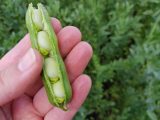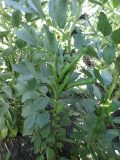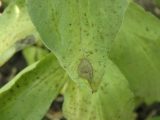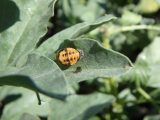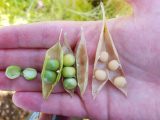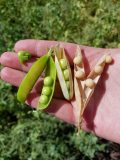August 5, 2020
- Crop Update
- Scouting Update
- Desiccating Field Peas
- Soybean Stem Diseases
- 2020 Pulse Maximum Residue Limits (MRL) Advisory
- Pre-Harvest Glyphosate Staging Guides for Faba Beans and Lentils
Listen to The Bean Report:
Crop Update
- Soybeans range from early pod (R3) to early seed development (R5). Most soybeans in the province are at or near full pod (R4).
- Dry beans range from early pod (R2) to 50% seed (R6). Most dry beans are at R3/R4 with advanced pod development.
- Peas are mainly at early to mid-maturity (R5/R6) this week, and range anywhere from late pod-fill (late R4) to full maturity (R7).
- Faba beans are mainly at R5 with full seeds within pods.
- Lentils are now at the full pod (R6) stage.
Scouting Notes
- Grasshoppers are moving into soybeans, causing damage at field edges.
- Pea aphids are still hanging around but shouldn’t pose much of a threat to peas and faba beans at this point in the season.
- Thistle caterpillar is still present, but not considered a crop pest despite its ugly appearance in soybean fields.
- Bacterial blight symptoms in pulse and soybean crops are advancing on leaves, pods and stems. New symptoms are also setting in from recent environmental damage.
- It’s not hard to find Mycosphaerella/Ascochyta symptoms in peas and faba beans, but the advanced staging of these crops should make them resilient against yield loss.
- Mid-season Phytophthora root rot is present in some soybean fields, along with early symptoms of northern stem canker. Be on the lookout for these and other stem diseases in soybeans.
- Crops look great overall, thanks to adequate moisture across the province. However, there are still some pockets in MB where plants are stressed from the lack of moisture.
Desiccation Timing in Field Peas
Desiccation is the application of a contact herbicide or true desiccant that will dry down plant material and advance harvest (Table 1). This article covers are a few questions to run through as you consider whether late-season herbicide is truly needed.
The optimal timing for field pea desiccation is when seed moisture is less than 30% in the least mature part of the field. Applying earlier will result in higher residue concentrations in the seed, can cause yield and quality loss and can lock in the green colour of yellow peas prior to colour change. Applying later, we need to consider each product’s pre-harvest interval (PHI).
Walk the field to inspect plants from different areas. Inspect pods for colour change, shake the plant for rattling seeds, shell pods and squeeze seeds from the upper portion of the plant to assess firmness and seed colour. And do that drive-by assessment or stand on your vehicle to get a picture of percent maturity across the field.
Yellow peas are ready for desiccation at R7 when:
- 80% of the plant has turned yellow to brown in colour in 75–80% of the field.
- Bottom pods are ripe and dry with seeds detached from the pod. Seeds rattle in the lowest pods.
- Middle pods are wrinkled and seeds within have changed colour.
- Top pods are wrinkled with an ‘orange peel’-like texture and have began changing colour. Seeds within top pods should have some colour change and split evenly when squeezed rather than squish.
Glyphosate is not registered as a desiccant in pulse crops but can be used for pre-harvest weed control. Like desiccants, it should only be applied pre-harvest when field pea seed moisture content is less than 30% to avoid residue levels greater than the maximum allowable limit.Farmers are advised to consult with their grain buyer before using this product on pulse crops. Some grain buyers may not accept pulse crops treated with pre-harvest glyphosate due to scrutiny in the global marketplace and low MRLs for some pulse crops in certain major markets. Glyphosate should not be used if peas are grown for seed due to the risk of reduced seed viability. For more information about pre-harvest glyphosate use, visit keepitclean.ca/glyphosate.
Soybean Stem Diseases
It’s important to identify stem diseases that may be present in your soybeans, as these pathogens can have a greater impact on production and quality than foliar diseases. These diseases include:
- White mould
- Phytophthora root and stem rot
- Northern stem canker
- Pod/stem blight
- Anthracnose
- Sudden death syndrome
The timeline for scouting is during the mid- to late-reproductive stages. Investigate the lower crop canopy in random areas of the field. Note that infected plants may or may not have upper-canopy symptoms.
Also be on the lookout for brown stem rot and charcoal rot, although they have not yet been confirmed in MB. If you suspect the presence of these diseases, contact us or submit a sample to a lab for confirmation.
On-Farm Network Update
August already! Hard to believe we’ll need our weigh wagons soon. Disease ratings in fungicide trials continue. With more moisture this season compared to the last couple of years, we are noticing increased disease pressure in some areas. It will be interesting to see how that influences yield results for pea, dry bean, soybean and faba bean fungicide trials.
This season we are working with Assiniboine Community College to assess canopy closure in our row spacing trials. So far, canopy closure measurements were taken at R1 and R3, with the third and final measurement slated for R5. At that R5 stage, they’ll also gather information on differences in late season weed pressure between spacings. We have trials comparing 15” vs 30” rows and 10” vs 20” rows this season.
As the season continues and you make observations on your own farms, questions and ideas may come up that could be great trial opportunities for the future. Whether it’s something you would like to test on your own farm next season, or simply a new trial type that would produce results useful to you, reach out! Get in touch with Megan at 204-751-0439 or megan@manitobapulse.ca
2020 Pulse Maximum Residue Limits (MRL) Advisory
Pre-Harvest Glyphosate Staging Guides for Faba Beans and Lentils
Bean App: Soybean Yield Estimator
Estimate your soybean yield prior to harvest to aid storage capacity and budgeting decisions. But remember, it’s only an estimate! Soybean yields are highly variable within fields. Increasing the number of samples and sampling from different areas of the field can improve the accuracy of this estimate.














